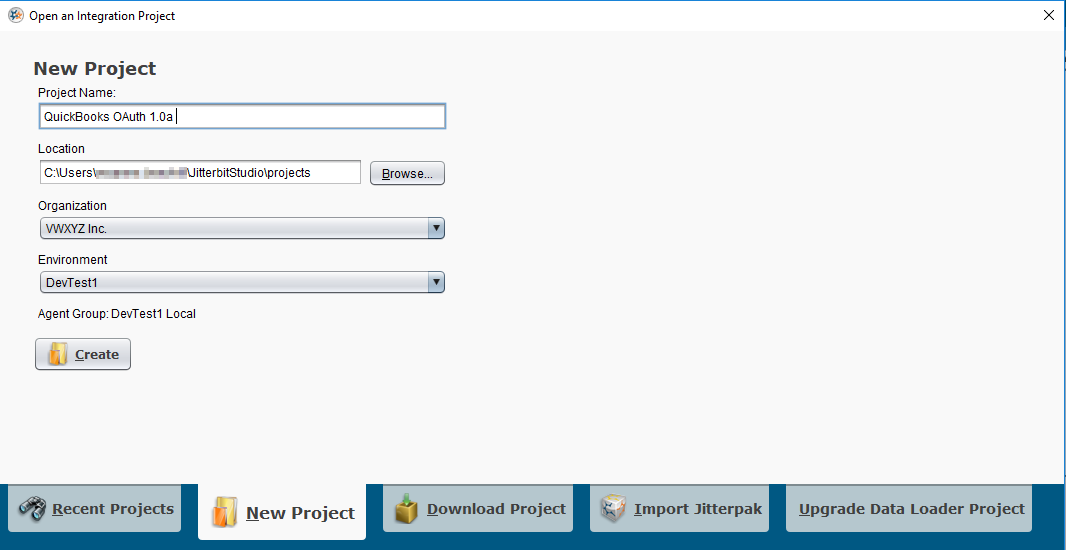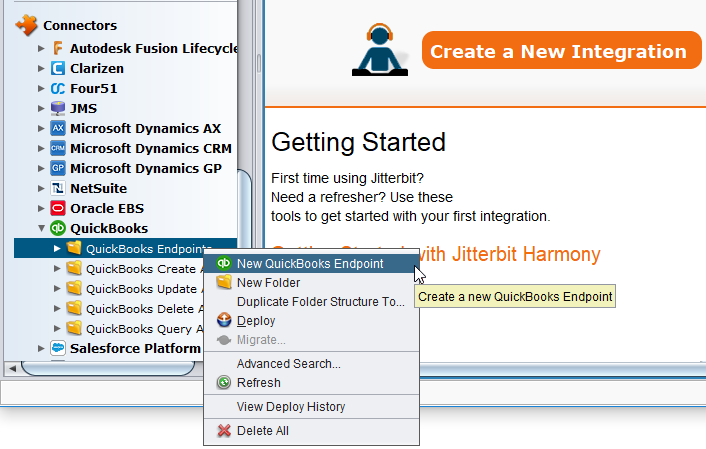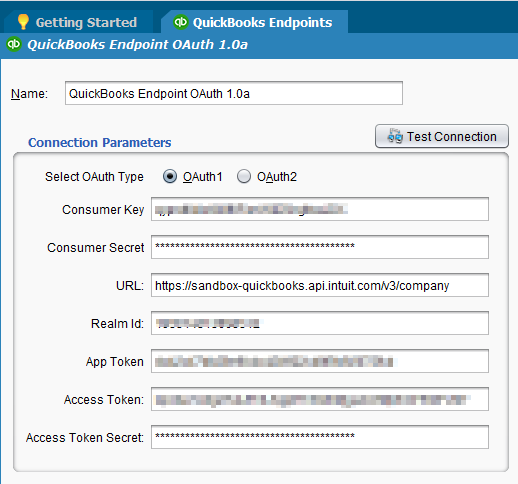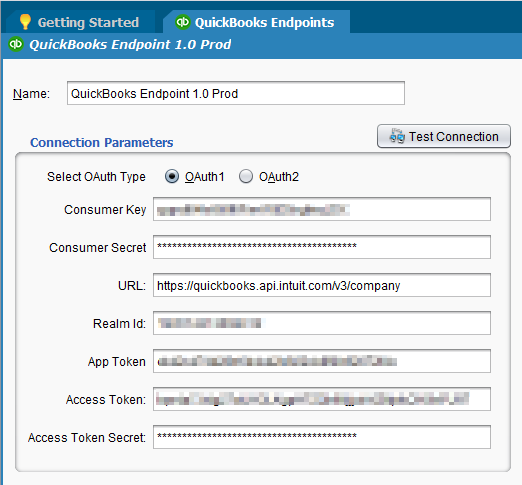QuickBooks connector OAuth 1.0a create an endpoint in Jitterbit Design Studio
Warning
All existing QuickBooks users are required to migrate to OAuth 2.0 authentication by December 17, 2019. See the Intuit Developer Blog Post April 10, 2019 and the Intuit OAuth Blog for additional information.
Before beginning the steps on this page, you should have already completed these setup activities to allow Harmony access to your QuickBooks Online instance:
At this point, you should have all the information you need to start working in Harmony. This page describes how to use the Harmony QuickBooks Connector to create an endpoint within Jitterbit Design Studio.
Note
If you are not already familiar with Harmony, you can visit Design Studio quick start guide for detailed information on how to use the product. For the purpose of this documentation, simple examples are used as a demonstration.
Testing endpoint
- Open the Design Studio application, version 8.10 or later. Sign in using the credentials created when you joined your Organization during the signup process through the Harmony website.
-
The Getting Started screen should display, where you may choose to do a variety of tasks. For the purpose of this walk through, we will create a new project. In the bottom tab portion of the Getting Started screen, click on New Project.
- Choose an appropriate name for your new project and then select other settings that are appropriate for your Organization. For purposes of this example we will call our project "QuickBooks OAuth 1.0a."
- If this is the first time that you have used Design Studio you may accept all of the default values.
- If you have used Design Studio previously, then you may want to change the selected settings as appropriate.
-
Click the Create button.

-
Once your new project has been created, your screen should be similar to the image shown below. The far left-hand side of the Design Studio shows the different parts of your integration: Operations, Transformations, etc. On the left-hand side, scroll down until you see the Connectors category. Double-click the QuickBooks Connector so that the underlying activities are visible. Then right-click on QuickBooks Endpoints as seen in the image below and select New QuickBooks Endpoint from the list.

-
On the right-hand side of the screen, you should see a new tab in your workspace called QuickBooks Endpoints. This is where you will set up the ability to connect Harmony to your QuickBooks sandbox instance using the values that were obtained previously in this documentation.

- Enter an appropriate name for the endpoint in the Name field. For purposes of this example we will call our endpoint "QuickBooks Endpoint OAuth 1.0a."
- Select the** OAuth1** radio button. The tab will now display the specific data fields required to create a QuickBooks OAuth 1.0a endpoint.
- Consumer Key: The Consumer Key is generated during the creation of the QuickBooks app as described in QuickBooks connector OAuth 1.0a - create QuickBooks app and is located on the Keys tab under the My Apps page within the Intuit Developer website. The Consumer Key was also used in the OAuth Playground to generate the Access Token and Token Secret.
- Return to the open browser window displaying the OAuth Playground page.
- Copy the Consumer Key from the OAuth Playground page and paste into the Consumer Key field within the test QuickBooks Endpoint tab in Design Studio as shown in the image above.
- Consumer Secret: The Consumer Secret is generated during the creation of the QuickBooks app as described in QuickBooks connector OAuth 1.0a - create QuickBooks app and is located on the Keys tab under the My Apps page within the Intuit Developer website. The Consumer Secret was also used in the OAuth Playground to generate the Access Token and Token Secret.
- Return to the open browser window displaying the OAuth Playground page.
- Copy the Consumer Secret from the OAuth Playground page and paste into the Consumer Secret field within the test QuickBooks Endpoint tab in Design Studio as shown in the image above.
- Access Token: The Access Token is generated within the QuickBooks OAuth Playground as described in QuickBooks connector OAuth 1.0a - create QuickBooks app.
- Return to the open browser window displaying the OAuth Playground page.
- Copy the Access Token from the OAuth Playground page and paste into the Access Token field within the test QuickBooks Endpoint tab in Design Studio as shown in the image above.
- Token Secret: The Token Secret is generated within the QuickBooks OAuth Playground as described in QuickBooks connector OAuth 1.0a - create QuickBooks app.
- Return to the open browser window displaying the OAuth Playground page.
- Copy the Token Secret from the browser window and paste into the Token Secret field within the test QuickBooks Endpoint tab in Design Studio as shown in the image above.
- Realm ID: The Realm ID is generated within the QuickBooks OAuth Playground as described in QuickBooks connector OAuth 1.0a - create QuickBooks app.
- Return to the open browser window displaying the OAuth Playground page.
- Copy the RealmId from the browser window and paste into the Realm ID field within the test QuickBooks Endpoint tab in Design Studio as shown in the image above.
- APP Token: App Token is generated within the Intuit Developer website as described in QuickBooks connector OAuth 1.0a - create QuickBooks app and is located on the Keys tab under the My Apps page within the Intuit Developer website.
- Return to the open browser window displaying the Dashboard tab within your app on the Intuit Developer website.
- Select the Keys tab.
- Within the Development Keys section on the Keys tab, click the Copy button to the right of the App Token and paste into the App Token field within the test QuickBooks Endpoint tab in Design Studio as shown in the image above.
- URL: This value is the URL of either the QuickBooks sandbox environment or the QuickBooks production environment, depending on which you are using. It can be copied and pasted into your URL text field as shown in the image above:
- Sandbox Environment: https://sandbox-quickbooks.api.intuit.com/v3/company
-
Once all of the necessary values have been supplied, click the Save** icon in the toolbar in Design Studio.
-
The connection should be tested to verify that everything is set up correctly. To do so, click the Test Connection button. The following popup should be displayed once Harmony has successfully connected to QuickBooks.
-
The above message confirms that the newly created sandbox connection is valid and is working. If the connection is not successful, the provided values should be double checked to ensure that there are no additional spaces, or a value was not fully copied and pasted into one of the connection properties.
Next Step: Once your Harmony endpoint has successfully connected to your QuickBooks sandbox instance, your next step is to create the appropriate activities to integrate your QuickBooks Online instance with other programs and applications.
QuickBooks connector - query activities
QuickBooks connector - create activities
QuickBooks connector - update activities
QuickBooks connector - delete activities
Production endpoint
When you are ready to bring your integration to a production environment, follow the steps below to create a production endpoint in Design Studio.
- Open the Design Studio application, version 8.10 or later. Select an existing QuickBooks project in the Recent Projects tab and click on the Open button, or click on the New Project tab and create a new project.
- On the left-hand side of the Design Studio, scroll down until you see the Connectors category. Double-click the QuickBooks Connector so that the underlying activities are visible.
- Right-click on QuickBooks Endpoints and select New QuickBooks Endpoint from the list.
-
On the right-hand side of the screen, you should see a new tab in your workspace called QuickBooks Endpoints. This is where you will set up the ability to connect Harmony to your production QuickBooks instance using the values that were obtained previously in this documentation.

- Enter an appropriate name for the endpoint in the Name field. For purposes of this example we will call our endpoint "QuickBooks Endpoint 1.0 Prod."
- Select the** OAuth1** radio button. The tab will now display the specific data fields required to create a QuickBooks OAuth 1.0a endpoint.
- Consumer Key: The Consumer Key is generated during the creation of the QuickBooks app as described in QuickBooks connector OAuth 1.0a - create QuickBooks app and is located on the Keys tab under the My Apps page within the Intuit Developer website. The Consumer Key was also used in the OAuth Playground to generate the Access Token and Token Secret.
- Return to the open browser window displaying the OAuth Playground page.
- Copy the Consumer Key from the OAuth Playground page and paste into the Consumer Key field within the production QuickBooks Endpoint tab in Design Studio as shown in the image above.
- Consumer Secret: The Consumer Secret is generated during the creation of the QuickBooks app as described in QuickBooks connector OAuth 1.0a - create QuickBooks app and is located on the Keys tab under the My Apps page within the Intuit Developer website. The Consumer Secret was also used in the OAuth Playground to generate the Access Token and Token Secret.
- Return to the open browser window displaying the OAuth Playground page.
- Copy the Consumer Secret from the OAuth Playground page and paste into the Consumer Secret field within the production QuickBooks Endpoint tab in Design Studio as shown in the image above.
- Access Token: The Access Token is generated within the QuickBooks OAuth Playground as described in QuickBooks connector OAuth 1.0a - create QuickBooks app.
- Return to the open browser window displaying the OAuth Playground page.
- Copy the Access Token from the OAuth Playground page and paste into the Access Token field within the production QuickBooks Endpoint tab in Design Studio as shown in the image above.
- Token Secret: The Token Secret is generated within the QuickBooks OAuth Playground as described in QuickBooks connector OAuth 1.0a - create QuickBooks app.
- Return to the open browser window displaying the OAuth Playground page.
- Copy the Token Secret from the browser window and paste into the Token Secret field within the production QuickBooks Endpoint tab in Design Studio as shown in the image above.
- Realm ID: The Realm ID is generated within the QuickBooks OAuth Playground as described in QuickBooks connector OAuth 1.0a - create QuickBooks app.
- Return to the open browser window displaying the OAuth Playground page.
- Copy the RealmId from the browser window and paste into the Realm ID field within the production QuickBooks Endpoint tab in Design Studio as shown in the image above.
- APP Token: App Token is generated within the Intuit Developer website as described in QuickBooks connector OAuth 1.0a - create QuickBooks app and is located on the Keys tab under the My Apps page within the Intuit Developer website.
- Return to the open browser window displaying the Dashboard tab within your app on the Intuit Developer website.
- Select the Keys tab.
- Scroll down to the Production Keys section on the Keys tab, click the Copy button to the right of the App Token and paste into the App Token field within the production QuickBooks Endpoint tab in Design Studio as shown in the image above.
- URL: This value is the URL of either the QuickBooks sandbox environment or the QuickBooks production environment, depending on which you are using. It can be copied and pasted into your URL text field as shown in the image above:
- Production Environment: https://quickbooks.api.intuit.com/v3/company
-
Once all of the necessary values have been supplied, click the Save** icon in the toolbar in Design Studio.
-
The connection should be tested to verify that everything is set up correctly. To do so, click the Test Connection button. The following popup should be displayed once Harmony has successfully connected to QuickBooks.

-
The above message confirms that the newly created production connection is valid and is working. If the connection is not successful, the provided values should be double checked to ensure that there are no additional spaces, or a value was not fully copied and pasted into one of the connection properties.
Next Step: Once your Harmony endpoint has successfully connected to your QuickBooks production instance, your next step is to create the appropriate activities to integrate your QuickBooks Online instance with other programs and applications.
QuickBooks connector - query activities
QuickBooks connector - create activities